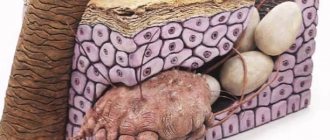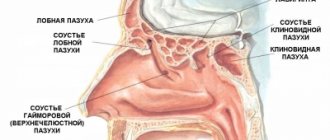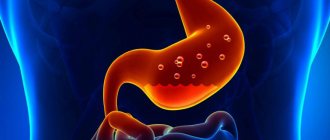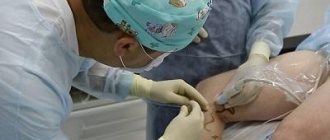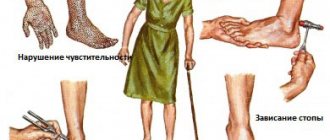Author
: Grachev Ilya Illarionovich
Editor
: Efremov Mikhail Mikhailovich
Publication date: 05/13/2014 Update date: 12/16/2021
Muscle pain, which can either intensify during movements or touches, or torment a person constantly, even at rest, is a reason to think about your health. Myalgia is the name of this common disease, and both older people and children suffer from it.
A large number of people around the world suffer from this disease, which negatively affects the quality of life, disrupting their usual routine. Myalgia is a disease that requires accuracy in diagnosis and correct, individual treatment. It has many manifestations and a variety of factors can trigger its development.
Myalgia does not go away on its own and has serious complications, so you should not delay treatment.
See how easily the disease can be cured in 10-12 sessions.
Causes of myalgia
It is very difficult to list all the causes of myalgia: the very lifestyle of a modern person is a negative factor that increases the chances of contracting this disease. The most common reasons include:
- Stress, prolonged emotional tension.
- Excessive physical activity overstrains the muscles, as a result of which myalgia develops, and a complete lack of exercise can also cause the disease.
- Infectious diseases such as influenza virus and ARVI. Spinal diseases, arthritis, radiculitis.
Exercise stress
“Body aches” after physical activity can occur both in untrained people and in professional athletes8. And the cause of discomfort is the accumulation of under-oxidized metabolic products in muscle cells; in particular, painful sensations are caused by an excessive amount of lactic acid (lactate)2. Less commonly, the cause is microtrauma, but this can only occur if the training rules are violated8.
Muscle soreness due to overwork does not occur immediately, but after a few hours or within 1-2 days after training or unusual physical activity and disappears within a week8.
Symptoms of myalgia
Basically, the symptoms of myalgia manifest themselves in the form of pain, and the pain can be of a different nature and concentrated in different areas. But not only the presence of pain indicates an illness. This disease is characterized by a number of other symptoms:
- Pain in muscles, joints, ligaments.
- Heaviness in the limbs.
- Hypertension, headaches.
- Dizziness, weakness, nausea and even vomiting.
What is POSSIBLE for diseases of the spine
What NOT to do for spinal diseases
Chronic fatigue syndrome and myalgia
This pathology is characterized by diffuse symmetrical muscle pain combined with asthenia, increased fatigue, which does not go away even after rest, which significantly reduces a person’s performance. In this case, increased fatigue must last for at least 6 months and cannot be explained by the manifestation of a somatic or mental illness. In other words, it is not possible to identify pathology on the part of the organs, there is no psychiatric history, there are no episodes of drug addiction, at least during the previous 2 years, that could give such a symptom. Chronic fatigue syndrome is characterized by a distorted perception of ordinary non-painful sensations (touch, sensation of heat or cold) as painful manifestations.
At the moment, there is no need to talk about the specific cause of the development of chronic fatigue syndrome. There are various theories of the origin of this syndrome: infectious, in particular associated with the herpes virus, supported by descriptions of epidemic outbreaks of this symptom complex; neuroendocrine; stress theory, which has received the greatest development at present. It is known that among females this pathology occurs several times more often, which is associated with greater susceptibility to stress due to psychological characteristics.
Treatment methods for myalgia
In our clinic, myalgia is treated using techniques that have stood the test of time for centuries. The wisdom of oriental healers and the achievements of modern medicine - this symbiosis allows you to comprehensively and effectively influence the existing problem, completely solving it. We offer the following treatment methods:
- Acupuncture. Using special needles, the impact on specific areas of the body allows you to quickly relieve muscle spasms and quickly relieve pain.
- Massage. Honey, acupressure or general massage allows you to quickly relax tense muscles and have a general relaxing effect on the entire body, due to which myalgia recedes. Pinched nerves are released, and metabolic processes improve.
- Hirudotherapy. The essence of the procedure is to stimulate bioactive points of the body through the bite of a medicinal leech. This method allows you to achieve an incredible reflex effect, since leeches not only mechanically affect the body, but also biologically.
- Stone therapy. The method is based on the healing power of heat; this heat not only relaxes overstrained muscles, but also has a positive effect on the blood circulation process, improving tissue nutrition and promoting their recovery.
- PRP therapy is the newest way to stimulate recovery processes. It is used to restore the functions of various organs after diseases and injuries, including to restore the function of the musculoskeletal system in case of myalgia.
We combine proven techniques of the East and innovative methods of Western medicine.
Read more about our unique method of treating Myalgia
Treatment of myalgia at the Paramita clinic
The main advantage of our clinic is accurate diagnosis. The examination is carried out to identify muscle tension. Attention is paid to the patient's symptoms and history. Thanks to a careful examination, effective treatment for myalgia is prescribed. After the first sessions, patients note that the pain gradually recedes and how much their overall health improves.
An individual approach, gentle but effective methods of influencing the problem and professionalism - these are the conditions due to which a quick and long-term result is achieved: myalgia recedes, and health problems cease to remind of themselves for a very long time!
Cost of treatment for myalgia
| Category I (acupuncture, vacuum therapy, moxotherapy - distant points) | 4000 rub. |
| Category II (acupuncture, vacuum therapy, moxotherapy, pharmacopuncture) | 4500 rub. |
| III category (acupuncture, pharmacopuncture, oriental manual techniques, acupressure body massage, stone therapy) | 5000 rub. |
| Category IV (acupuncture, vacuum therapy, moxotherapy, acupressure body massage, oriental manual techniques, stone therapy) | 6000 rub. |
| V category of complex treatment by the head physician (acupuncture, vacuum therapy, moxotherapy - remote points) | 7000 rub. |
Sign up for a free initial appointment
Classification
The classification is based on various criteria, according to which the following are distinguished:
- According to pathological changes in the muscular-ligamentous apparatus: fibromyalgia (primary/secondary), myositis (polymyositis), epidemic myalgia .
- According to the nature of the course: acute, chronic.
- According to the location of pain: localized, diffuse.
- According to the level of the CPK enzyme (creatine phosphokinase) in the blood: with an increase in CPK activity and without a change in the level of CPK.
Stages of the disease
- Sometimes the disease is preceded by a feeling of malaise and weakness.
- The pain may gradually increase or, conversely, suddenly manifest itself.
- A “myopathic syndrome” appears when climbing (from a sitting position, up stairs) and the pain intensifies.
- There is a feeling of stiffness and limited body mobility.
- There is a feeling of constant tension.
- If the cause of the disease is serious enough, the next stage may be pain in the joints and bones.
- Possible fever and chills.
List of sources
- Shostak N. A., Pravdyuk N. G., Novikov I. V., . Trofimov E. S. Myalgia in therapeutic practice – approaches to differential diagnosis, treatment // Attending physician. No. 3 p. 21-24.
- Ivanichev G.A. Pathogenetic aspects of the formation and manifestation of classical muscle pain syndromes. Manual therapy. 2009; 3 (35): 3–12.
- Busheneva S.N., Kadykov A.S., Piradov M.A. Myofascial syndrome: from theory to practice. Russian medical journal. 2005; 22. p. 57-62.
- Godzenko A.A., Badokin V.V. Local therapy of myofascial pain syndrome. RMJ. Rheumatology. 2007; 26: 1998–2003.
- Osipova N. A., Abuzarova G. R., Petrova V. V. Principles of using analgesics for acute and chronic pain. Clinical recommendations. M.: FSBI “MNIOI im. P. A. Herzen” Ministry of Health and Social Development of Russia, 2010. 67 p.
Diagnosis of myalgia
Many people do not attach importance to muscle pain, considering it a consequence of fatigue. But it should be understood that all processes in the human body are closely connected; damage to one of the systems can unpredictably affect the other. Therefore, it is better to use modern diagnostic methods:
- collecting the patient's medical history;
- Ultrasound of superficial muscles;
- MRI for muscle groups located deep in the body;
- taking samples for infections;
- Needle electroneuromyography is performed to assess muscle activity.
Polymyalgia rheumatica
In most patients, RP begins acutely , with severe pain and stiffness, mainly in the muscles of the neck and shoulder girdle, less often (in one third of patients) in the muscles of the pelvic girdle and thighs. N.V. Bunchuk and S.S. Nikitin noted characteristic pain in RP, which has a certain diagnostic value. Localization of pain is the neck area, shoulder joints and shoulders, buttocks, hips. The pain is usually cutting, pulling, jerking in nature, the intensity of which is associated with the activity of the disease. Myalgia and stiffness intensify in the morning, with any movement, and at night in those muscle groups that are subject to stress, including the heaviness of the body. It is characteristic that the pain does not bother the patient in complete rest, when taking a comfortable position. Myalgia and stiffness are usually symmetrical in nature, accompanied by limitation of movements in the shoulder and hip joints, and the cervical spine. Noteworthy is the discrepancy between the severity of subjective sensations and the absence of pain or little pain when palpating these areas. Thus, in most cases, it is not possible to detect significant changes in the shoulder and hip joints, periarticular tissues, with the exception of slight pain on palpation of the muscles and tendon-ligament apparatus, in particular in the area of the greater tubercle of the head of the humerus, sternoclavicular and clavicular-acromial joints. There is no atrophy or infiltration in the muscles of the shoulder or pelvic girdle.
Active movements in the cervical spine, shoulder and hip joints are sharply limited, so patients find it difficult to dress, comb their hair, wash, squat, get up from a low chair, go up and down the stairs. The gait changes, the step becomes small, mincing. It is extremely important that passive movements are less limited than active ones. Nonsteroidal anti-inflammatory drugs or analgesics reduce myalgia only for a short time, while prednisolone, even in small doses (10-15 mg/day), has a rapid clinical effect.
Among other manifestations of RP, it is necessary to note arthritis, which was noticed only in recent years after examining patients using scintigraphy. LA Healey most often found signs of arthritis in the shoulder, sternoclavicular, wrist and knee joints. Arthritis is usually unstable and is easily relieved by intra-articular administration of hydrocortisone or oral corticosteroids.
The signs listed above are usually accompanied by general weakness, decreased appetite, weight loss, and increased body temperature. The severity of these signs is usually related to disease activity.
In a number of patients, tachycardia and pain on palpation along the large arterial trunks are detected. In some cases, pain in the extremities acquires a peculiar character, paresthesia, sensations of chilliness, and numbness appear, which are usually associated with the development of temporal arteritis. Temporal arteritis is also manifested by headache, sensitivity to palpation of the scalp, especially the arteries of the temporal region, and blurred vision. The headache is usually one-sided, severe, and most severe at night. It can begin suddenly and in about one third of patients is the first symptom of the disease. Pain often radiates from the temporal region to the neck, lower jaw, eyes, ears, simulating maxillofacial neuralgia, temporomandibular joint arthritis, or even a brain tumor. When examining the area of the temporal artery, you can detect painful thickening of the walls of the vessels and the absence of their pulsation, swelling of the tissues surrounding the artery. Almost half of patients with temporal arteritis have impaired vision. It gradually or suddenly decreases, a number of patients develop diplopia, and approximately 10% may experience blindness in one or both eyes as a consequence of ischemic optic neuropathy or hemorrhagic changes in the retina. The sudden development of cerebral disorders and disruption of the patency of the great vessels (pulse asymmetry, pressure, vascular murmurs) are of great diagnostic importance.
Of the laboratory tests for RP, the most important is an increase in ESR, sometimes reaching 60-80 mm/h. Many patients have slight normochromic anemia (100-110 g/l). It can be stated that there is a high level of fibrinogen, α2globulin, CRP and other acute phase proteins. RF, AHA are not detected, the level of antistreptolysin is normal.
An electromyographic study of the muscles in the area of which pain was noted does not reveal significant changes, but occasionally a small degree of decrease in the average duration of motor muscle potentials or single fibrillation potentials are recorded.
Types of Arthralgia
In medicine, there are several classifications of types of arthralgia: 1. according to the number of affected joints:
- monoarthralgia – one joint
- oligoarthralgia – up to five joints
- polyarthralgia – more than five joints
2. by localization:
- arthralgia of the knee joint
- arthralgia of the hip joint
- elbow joint pain
- pain in the shoulder joints
- other types are rare (wrists, ankles, finger joints)
3. due to the occurrence:
- infectious
- appearing against the background of osteoarthritis
- appearing against the background of arthritis (psoriatic arthralgia, rheumatic, gouty, reactive)
- accompanying other joint diseases
- post-traumatic
- accompanying cancer
- pseudoarthralgia
PREVENTION OF MUSCLE DISEASES
Preventive measures include a number of simple rules:
- avoid hypothermia, wear seasonal clothing;
- carefully follow all doctor’s orders for any disease;
- do not self-medicate;
- practice a healthy lifestyle;
- use regular exercise.
It is best to practice under the guidance of experienced instructors who will select an individual rehabilitation program and help you achieve a quick and high-quality recovery. This is the approach that the specialists at the Center for Restorative Medicine follow. The cost of admission and other details can be found on the Center’s website or by calling.
MYOSITIS
Myositis is a group of diseases that manifest as inflammation in muscle tissue. Myositis is caused by various reasons, on which the prognosis of the disease depends. This problem is often encountered by people in professions that involve constantly being in one (often physiologically uncomfortable) position: drivers, musicians (violinists, pianists), athletes (tennis players), programmers, and so on.
Common reasons may be:
1. Infections of a viral or bacterial nature (flu).
2. Autoimmune diseases (rheumatoid arthritis, scleroderma, lupus erythematosus, etc.).
3. The influence of toxic substances (alcoholism, drug addiction).
4. Long-term use of certain medications.
Myositis - symptoms and treatment
The disease is manifested by the appearance of aching or dull pain in the affected tissues. It intensifies with movement or pressure. Muscle weakness is often noted. Redness and swelling of the skin are rare. The most common are cervical and lumbar myositis. They develop due to constant exposure to an uncomfortable position, due to hypothermia, or previous diseases. Often the pain radiates to other areas and intensifies with activity. Treatment is aimed at suppressing inflammation, maintaining a healthy lifestyle, and using dosed physical activity.
MYASTHENIAS
A disease of the autoimmune system that causes muscle weakness due to interruptions in neuromuscular transmission is called myasthenia gravis. The activity of the ocular, facial and masticatory muscles is usually impaired; the muscles of the respiratory organs are less commonly affected. Characteristic manifestations: drooping of the lower eyelid, disturbances in vocal function (nasal sound, hoarseness, hoarseness or weakness), disturbances in swallowing and chewing.
The word "myasthenia" means impotence, muscle weakness. This is a pathological process, which is based on the self-destruction of body cells. The normal immune response changes direction and begins to destroy its own cells instead of foreign ones, which leads to the destruction of organs and tissues of the body.
Possible reasons:
- genetic predisposition;
- benign or malignant tumors;
- systemic diseases;
- damage to the nervous system;
- hyperthyroidism, sleeping sickness.

